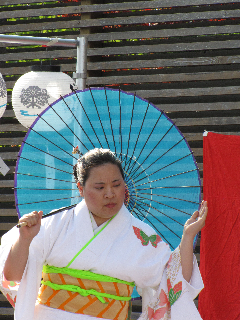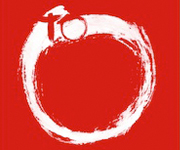14 Jul
An impressive display of non-stop performances and culinary delights highlighted this double festival. Also pleasing visitors were activity booths and crafts. Children and adults dressed in vibrant Japanese summer cotton added to the colour. These all made for a marvellous introduction to this double festival last weekend at the Japanese Canadian Cultural Centre.
Natsu Matsuri is a summer activity, the dancing often performed by high school students.
Obon Festival is a Buddhist event commemorating ancestors. Organizers prepare special foods and decorate using lanterns. Everyone can join in the Bon Odori, a more sedate welcoming dance.
I was particularly charmed by the children’s activities. One booth for under sevens was especially good. It had a small pool filled with tiny soft-coloured plastic fish. The children attempted to scoop up the little fish with a net before a ripple swooped the fish away. The children were mesmerized.
The food was different from other festivals. Friends told me it wasn’t traditional even for these festivals. There were octopus balls and pancakes of egg and vegetables that were topped with bonito-fish flakes. One of my picnic lunch favourites was offered. They are huge home-made rice balls with great slabs of nori-seaweed. They are delicious.
Many vendors had brought articles for sale such as credit card holders, aprons or toys made from brightly patterned old kimono material. One booth had exquisite washi – hand made paper in sheets that you could use for wrapping, paper-folding or origami.
These activities quietened down as the spectacular evening performance began. I felt transported to a magical world watching the dancers and could not help but join in.
Promptly at 7.00 p.m. the promised 100 Yukata-costumed male and female dancers lined up outside. The performance began with a meditative silence in front of a shrine to ponder on ancestral spirits.
A woman sitting beside me explained that the elderly loved these dances. Even if they usually needed support from a cane, they discarded them to dance. She said all the experienced dancers had made their own Yukatas.
The master of ceremonies encouraged everyone to join the dance. A special energy seemed to touch those who did. Dancers waved at friends as they gracefully moved by. Inspired by the music, the number of dancers doubled quickly. Dancers even swept up a couple of small dogs and cradled them as they swayed together in rhythm.
Young children easily four and five seemed anxious to learn the steps and add their own personal 21st century touch. What especially caught my eye was a young boy about six who was very intent in getting the steps right. He was sprouting a perfect Mohawk. – P. Anne Winter.


